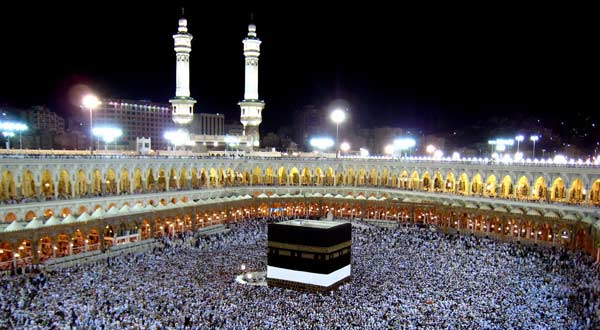Islam is the universal religion and the foundation of Islam is based on five pillars: Proclaiming Oneness of God, Praying five times (salah), Fasting, Zakat (charity) and Hajj. Without these pillars the foundation of Islam is weak. Hajj is the last pillar. Hajj is one of the most important acts of worship that a Muslim will ever experience. Performing Hajj once in a lifetime is obligatory on every Muslim who can financially afford it. It requires extensive planning, training and commitment. Both the Hajj and the following Eid al-Adha are based on remembrance of Prophet Ibrahim and his family and their faith in Allah. Hajj is the biggest gathering in the world. Every year nearly three million people from every corner of our planet travel on pilgrimage to Makkah, Saudi Arabia.
The great annual convention of faith demonstrates the concept of equality among mankind, the most profound message of Islam, which allows no superiority on the basis of race, colour, country, language, gender or social status. It shows equality as well as simplicity among people. The dress code for Hajj is a simple two-piece unstitched white cloth. So when a person performs Hajj, he is unaware whether the person standing next to him is a millionaire or poor. With this uniform gathering, Islam wants to show that everyone is equal before God. The dress shows a rejection of luxury and decoration and it helps to think of the Day of Judgement.
Islam teaches that a person only excels over another in their piety and good deeds. The pilgrims respond to Allah by their actions and they proclaim labaik allahumma labbaik which means ‘here I am, Lord, here I am’. This shows submission to one God and to promise that we will avoid all forbidden activities and only follow his commands. The pilgrims after arriving in Makkah, circumambulate around Ka’aba. Ka’aba is the first House of God ever built on earth. It is the centre of the great mosque and also the direction for all Muslims to pray throughout the world. It signifies that all are praying in one direction. It also shows the unity among Muslims. In standing near Ka’aba, there is a lesson of commitment to Allah, to follow all that is good and shun evils. When pilgrims stand on Mount Arafat all together praising God, they seek forgiveness and supplicate to Him. Here is a lesson in equality, liberation and training for that we have to stand before Allah on the Day of Judgement. Hajj is also a Universal Conference where they meet their fellow brothers and sisters in faith from all over the world. This gives the clear living example of brotherhood in Islam. It reminds us of the Universal Brotherhood. Performing rituals of Hajj shows equality, simplicity, sacrifice, patience, charity, etc. The spirit of Hajj is turning to Allah wholeheartedly in humble and passionate love and devotion.
The pilgrims acquire the talent of remembering Allah in all that they do, so that they become closer to Him. Pilgrims in their rituals remember Hajar, the wife of Prophet Ibrahim whom he had left in the dry valley with his new-born child by the order of God. This is another act of remembrance when we are re-enacting the actions of Hajar as she frantically searched for water to give to her son Ismail after Ibrahim leaves her in the wilderness. She ran between two mountains named Safa and Marwa seven times while searching for water. Then Allah provided her with His help and steadfastness by having the water of Zamzam flow from underneath the feet of her baby. As part of our worship we also drink the Zamzam water. If we ponder on the history and study the sacrifice of Prophet Ibrahim, then Hajj and Eid al-Adha is all about remembrance of Prophet Ibrahim. Eid al-Adha is celebrated in remembrance of Ibrahim’s willingness to sacrifice his son in accordance with Allah’s will, though in the end Allah provides him with a sheep to sacrifice instead.
When Allah asked Prophet Ibrahim to sacrifice his son the shaithan tried to distract him and dissuade him from following Allah’s command. He stopped him three times from whispering against Allah and stoned shaithan with pebbles. These rituals are followed by Muslims today also by the pilgrims. As Ismail was replaced with a sheep, lamb is the traditional thing to sacrifice on that day. In remembrance, Muslim faithfuls slaughter sheep, camels, goat and other cattle in an act of sacrifice to show gratitude for their blessings, divide it into three equal portions and give some of it to the poor. Eid al-Adha ends the period of Hajj. Even the people who do not perform Hajj that year celebrate Eid al-Adha at their respective places.
Today we live in a materialistic world. Modern consumerism and mass production has had a negative impact on the society. We want more and we want it instantly. In this age of political instability, racial violence, greed and materialism, we are not ready to sacrifice anything. It is a time for us to change our consumer mindset and apply the principles of sacrifice into our lives by remembering the sacrifices of Prophet Ibrahim.
The beauty of Islam lies in its power to be relevant throughout many centuries. The lessons embedded in the story of Prophet Ibrahim and Prophet Ismail can be applied even in today’s social life. They remind us to be cautious with our actions and patience when facing the trials of Allah because sacrifice must be made in order for us to feel a higher level of closeness to our Creator.
Hajj Pilgrimage the Last Pillar of Islam
Islam is the universal religion and the foundation of Islam is based on five pillars: Proclaiming Oneness of God, Praying five times (salah), Fasting, Zakat (charity) and Hajj. Without these pillars the foundation of Islam is weak. Hajj is the last pillar.


